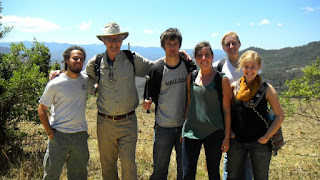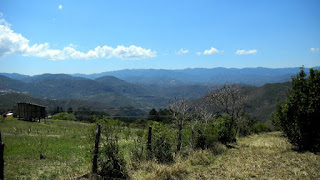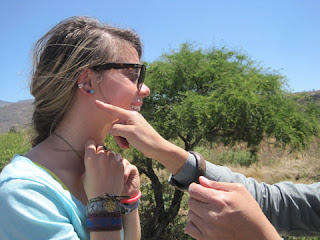 Teotitlán del Valle at sunset
Teotitlán del Valle at sunset This past week, Kristof, Isaac, Zoe, Erin B, Danielle, Heidi, and Rachel travelled to Teotitlán to stay with Vida Nueva. Vida Nueva is women’s cooperative to create economic and artistic opportunities for Zapotec Women. We each lived with a woman from the cooperative, taking part in daily activities. With a fairly open schedule, we received a true glimpse of daily life for these women and their families. Because we stayed in different homes, we each had extremely different experiences.
Rachel Levin:
Heidi and I stayed in the home of Zonieda and her extended family. Her family included Milca (a drooling five year old girl), Milca's parents, and Zonieda's father, Masunte, a 71 year old healer. This made for some crazy family dynamics with little to no silence. Their home was nestled at the bottom of Picachu, a sacred mountain that I had the opportunity to hike twice at sunrise! Zonieda works at the Teotitlán market, selling fresh fruit and vegetables every morning. It was extremely interesting living with a curandero (a traditional medicine healer) because his beliefs regarding health were tightly integrated into the family's way of life. I ate the best (and the most) food I have experienced while in Oaxaca. Isaac, Kristof, Heidi, and I had the opportunity to learn to make tamale amarillos which were delicious (we definitely did not impress them with our tamale making skills). On Thursday, we got to do a temazcal which is a ritualistic vapor bath. I was touched by the hospitality of all of the women of Vida Nueva.

Kristof emerging from the temezcal
Erin
I have discovered in my own life that certain “places” are special to families. Places such as where we were born, home, vacations we visit as families, or the common trips a family could have taken to grandma’s house. The dinner table is probably the most sacred place of any family. Here at the dinner table we grow up eating next to one another, learning and communicating about each other. The dinner table is the one “place” which doesn’t let us forget our origins and stays with us forever. I spent many afternoons and evenings sharing meals with the entire family of Silvia and Felix in Vida Nueva. We even had a birthday dinner for Eric, their son. I have relearned this week that throughout all our lives it is family that knows us best. Felix took time this past week to teach me how to make a tapete. Although, I only stayed with one specific family I learned what the family's functions were within the community of Vida Nueva. Felix was very proud of his life work with tapetes, he was also a very proud father of three boys.
Zoe:
An interesting experience that tested me in many ways. I lived with a family consisting of only 2 people, a daughter Teresa and her father. Upon arriving to their house I could imediatley see the differences between city living and village living. Village living is much more tranquil and connected to nature. The houses were much simpler and the floors all made from either concrete or dirt. The kitchen was outside under a small metal awning and the toilet was difficult to use for a tall east coaster, like myself. There were many plants in the courtyard that were flourishing and bright with color. I could feel living here was different that in the city as well. Each activity was completed slowly and there was a routine to the day where everything that needed to be done got done and if it did not, the mentality seemed- "there's always tomorrow."
For me village life was a bit to slow. I am used to fast pace living, always being consumed with activities and a to-do list that needs to get done today. With all my free time I fell back in love with reading and finished a book, "A hundred secret senses" by Amy Tan. (highly recommendable!!) and i realized I need to prioritize reading into my daily routine because it was so enjoyable and relaxing.
The last thing I have to comment on is the rugs they created. All of them done with such care and creativity. The patterns that can be created on the loom and the colors that can be made from natural materials were brilliant and I will never stop being impressed by the craftsmanship and dedication of the people.
Heidi Bergt:
Upon arriving in Teotitlan, I wasn't exactly sure what I expected from the week to come. What I came to realize over the course of the week was that anything I had expected was not the case. Overall, our time with the women of Vida Nueva was a very rewarding experience, but it was also very eye-opening in regard to what life in Mexico is really like. I enjoyed the opportunity to step out of our bubble in Oaxaca City and experience this culture firsthand. It was also a privilege to work with such incredible women in the weaving cooperative. Vida Nueva is comprised solely of single, widowed, or divorced women, and their community outreach and efforts to improve women's rights is amazing. Rachel and I stayed with Zenaida, a single woman who lived with her younger sister, her younger sister's husband and five-year-old daughter, and her 71-year-old father, Jasunte. Jasunte is a curandero, a traditional healer, and always had a story (or two, or six) to share at the dinner table. Although our week lacked any sort of formal schedule, it allowed us to truly capture the atmosphere of living in the village. The days meandered by with slow walks in the relentless sun to get pan dulce or a trip to the molino (mill) to grind corn for tortillas. We learned the art of making tamales, went hunting for guayavas to sell at Zenaida's stand in the market, and even had the immense privilege of taking a temazcal. Alas, Friday rolled around and it came time to bid farewell to our welcoming hosts. I was surprised at how sad I felt to be leaving these people I hardly knew, and we said our good byes with many promises to come back. Although I was quick to deem life in Teotitlan "simple", it was far from that. The complexity of the community fabric and the web of relationships, responsibilities, and customs would take far more than a week to even begin to comprehend. The village stay will be one of the most distinguished memories I think I will take away from Oaxaca.

















































